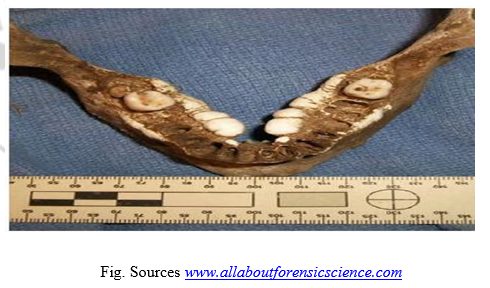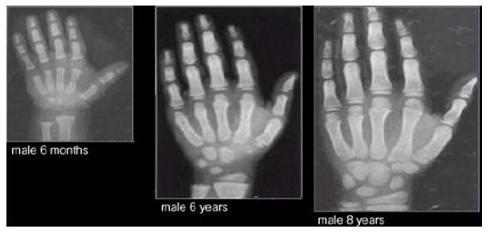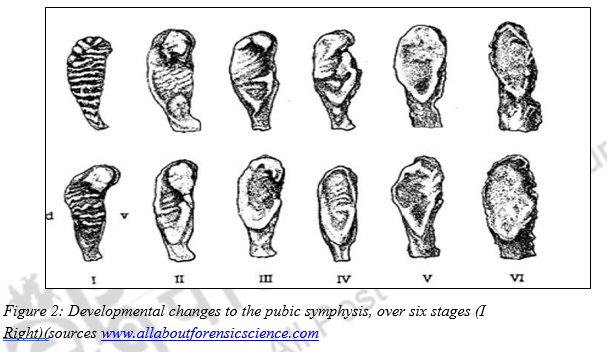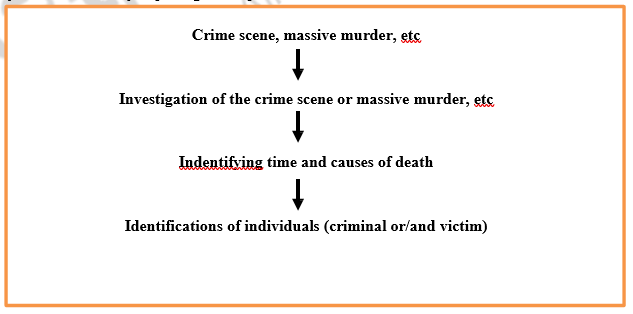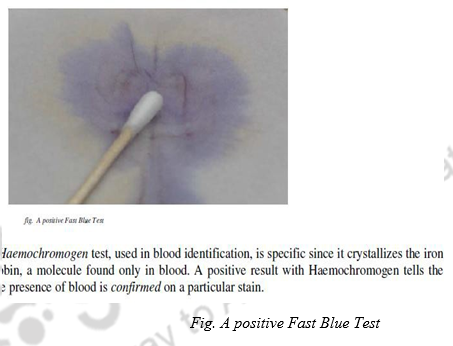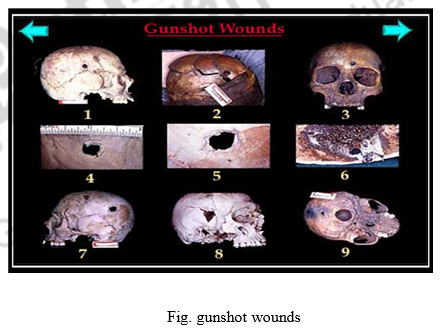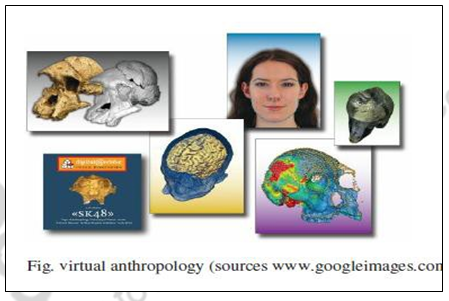7 Anthropological perspective of forensic anthropology
Introduction:
Anthropology is derived from two Greek words anthropo and logo, anthropo, meaning ‘Human being’; and logos, meaning ‘speech’ or ‘talk about’, it can be, thus described as the study of Humanity. The anthropologist Eric Wolf once characterized anthropology as “the most scientific of the Humanities and the most humanistic of the social sciences.” It is basically the study of humans being in totality, and it manifests in several sub-fields as:
- Cultural and linguistic anthropology – the study of the aspects of human society and language,
- past and present
- Archaeology – the study of past cultures via material remains and artifacts; and
- Physical or biological anthropology – the study of human evolution, variation and adaptation.
Understanding how anthropology developed, contributes to understanding how it fits into other academic disciplines. Other disciplines in physical anthropology are: genetics, human growth and development, primatology, paleo-anthropology, human osteology (study of the skeleton), paleo- demography (vital statistics of past populations), skeletal biology, nutrition, dental anthropology, human adaptation and variation.
History
We have been fascinated by for thousands of years, nearly as long as anatomically modern humans (Homo sapiens) have been around. Around 15th century, when Europeans came in light by colonizing America, sudden interest was developed in indigenous population as because they looked different in Various ways like the type of clothes they wear, language they speak, buildings they build, almost Everything was different. Thus the Europeans attempted to classify the populations into groups based on physical and social traits (height, face shape, language and region). But that time science was very little .In 19th century, as the science developed and acquired a tentative foothold in the human development and diversity. Fossils were studied, measurements of living subjects were made , and Charles Darwin published his groundbreaking on the Origin of Species in which he discussed how natural selection shaped human (and other animal) evolution and development. However, forensic anthropology as we know it made late appearance to the biological anthropology field. Its history can be divided into four periods.
- Formative period (1849-1938)
- Consolidation period (1939-1971)
- Modern period (1972-1999)
- Fourth era (2000- )
Forensic anthropology
It is a sub-discipline within the subfield of physical anthropology. It involves the application of scientific techniques developed in physical anthropology and anthropological knowledge in a legal context to aid detection of crime such as homicides, bank robberies, murder, rape, child sex abuse, accident, massive destruction, accidents etc. It borrows methods and techniques developed from skeletal biology and osteology and apply them to cases of forensic importance. Generally speaking forensic anthropology is the examination of human skeletal remains for law enforcement agencies to determine the identity of unidentified, particularly by bones, since bones often survive the process of decay and provide the main evidence for the human form after death. Through the established methods, a forensic anthropologist can aid law enforcement in establishing a profile on the unidentified remains. A forensic physical anthropologist can assist in the identification of deceased individuals whose remains are decomposed, burned, mutilated or otherwise unrecognizable. The profile includes sex, age, ethnicity, height, length of time since death, and sometimes the evaluation of trauma seen on bones.
Various fields of forensic science:
Forensic biology: Forensic Biology involves the examination of exhibit material to recover sources of DNA for subsequent DNA profiling.
- Biology Analytical (extraction, quantization, amplification of DNA) and
- Biology Reporting (application of DNA profiling software, comparison of generated profiles and Statistical interpretation of any matches obtained).
In the Biology Discipline, assault cases are the majority of cases that are examined. They sub-classify into the various degrees of sexual and aggravated assault and, the most ultimate of assaults: homicide.
Forensic chemistry: Forensic chemistry in Canada refers to the chemical analysis of materials in support of the Justice System. This includes the analysis of fire debris for ignitable liquids, Gun Shot Residue (GSR), paint, glass, fibers, explosives, building materials and soil. Forensic chemists analyze any trace evidence that is not a body fluid.. These are normal, everyday products which we don’t normally think of in relation to crimes. But crimes occur in everyday places such as houses, offices, gardens, streets and sidewalks. So these ‘everyday’ materials are frequently of interest at a crime scene due to the potential transfer from offender to victim and victim to offender. This exchange of materials is known as Locard’s Exchange Principle, stating that every contact leaves a trace.
Forensic toxicology: Forensic toxicology is quite different from forensic chemistry. Whereas a forensic Chemist performs chemical analyses of a myriad of everyday materials, forensic toxicologist’s concentrateon the chemicals found in body fluids, primarily drugs, alcohol, and poisons and with chemicals related to the making and using of drugs such as methamphetamine labs, needles and spoons.
Forensic pathology: It is the application of medical science (study of the human body and its injuries and diseases) to legal problems. Forensic pathologists (FPs) are physicians with particular expertise in injury interpretation and death investigation, including determination of cause and manner of death. They are trained to perform autopsy examinations and this comprises the majority of their workload.
Forensic odontology: helps identify victims of crime or accident, but can also help to solve rapes, catch Child molesters and even catch killers. There are many ways forensic dentistry can help in an Investigation. The human dentition is particularly valuable in victim identification because of the Survivability of dental structures. Enamel is the hardest substance in the human body, followed by dentine and thirdly by bone. A tooth therefore, is resistant to changes associated with time, water, decomposition, drying, and temperature. Dental fillings used to repair & replace teeth are also resistant to many of the same common factors, making them easily identifiable as well. Restorations are stable to all the same factors as teeth, and some can even resist temperatures in cremation of anatomical remains.
Bite Marks: Biting is a common aggressive act especially during sexual encounters and like finger prints, can put a suspect at the crime scene. Bite marks can be both offensive and defensive. Offensive biting by the attacker is used to gain control of victims by inflicting pain. Defensive bite marks are done by victims
- anthropology
- socioculture
- medical
- linguistic biological
- forensic
- Paleopathology
- osteology behavioural
- ecology
- archaeology
To fend off an attack; to leave evidence behind; or can be self-inflicted to mask other trauma from an Attack.
Anthropological perspective
An anthropologist attempt to incorporate knowledge from every possible sphere in to meaning full Understanding of humanity, by its holistic approach, along with culturally neutral ethno relativistic stand and participant observation. The holistic approach helps an anthropologist to look his area of study from all angles. By adapting a culturally neutral stand an anthropologist is analyze an event/ behaviour in terms of its internally consistent logic and rationale, without being judgmental about it. Non judgmental appreciation of the strength and weakness has been an article of faith with the anthropologist. The training of anthropologist for participant observation help him to enter into skin of his subject to get an insider view without getting swayed by it. These tenets of anthropology are used by trained anthropologist in solving various problems and issue of human society and forensic cases are no exception to it.
Involvement of Anthropologist:
In Exhumation and identification of victim of war, ethnic cleansing and /or genocide an Anthropologist Work as a part of multidisciplinary team. The works by definition is multidisciplinary and integrate all Four field of Anthropology; biological, cultural, archaeological and linguistic. Following responsibilities are accorded to forensic anthropologist in a multidisciplinary forensic team;
• To maintain scientific integrity of the investigation;
• To maintain and conform appropriate legal convention of investigation
• Fulfill his responsibility to the local community affected by the events.
An expert Forensic Anthropologist (FAs) is expected to know, how to cope up with where ideal protocol and methodologies are followed, however in situation where these ideals and methodologies are not pragmatic or unavailable, he must understand what “ideal” without losing necessary information.
Analysis of remains:
FAs prepares the skeletal inventory depicting presence/absence and duplication of element besides Assessment of condition of remains including Taphonomic (decomposition) assessment of post mortem stage (staining, carnivore/rodent is gnawing, root etching).A standardized view of skeletal remain are taken indicating the following:
- Skeletal overview of individual in a anatomical order
- Maxillary and mandibles dentition
- All elements use to establish age of individual
- All Antemortem traumas or pathology and all Perimortem traumas.
- The Forensic Anthropologist Examines Following Questions :
- Is It Bone?
- Is It Animal Or Human Bone?
- How Many Individuals Are Represented?
- Evidence For Time Since Death,
- Sex Of The Individual,
- Age At Death
- Ancestry (“Racial” Origin),
- Stature (Height) Of The Individual,
- Evidence Of Trauma That May Assist In Determining Cause (The Exact Reason Someone Died) Or Manner
- Of Death (Homicide, Suicide, Accidental, Natural Or Unknown),
- Any Individualizing Features Such As Evidence Of Medical Devices; Bone Anomalies; Bone Pathologies (Disease Processes), Old Fractures, Fingerprints, Amputations, Etc., And Finally,
- Identity Of The deceased.
Biological profiling of human remains; determination of sex, age, ancestry, stature, and identification of victim Determination of various elements of biological profile
Biological profiling of human remains includes determination of:
– Sex
– Age
– Ancestry
– Stature, and
– Identification of victim.
Sex: Sex not gender must be assessed first, before dealing with the method for determination of sex, it Would be apt to differentiate sex form gender, sex is biological consequence of chromosomal inheritance whereas gender is social construct based on self identification of individual in his/her culture. Sex difference may be observed in a human Skelton after onset of puberty. No attempt should be made to determine sex of an individual whose in nominate are not fused at Acetabulum. DNA can be used for determination of infant and juvenile. Caution must be applied when transferring anthropological technique from one population to other , until anthropologist became familiar to normal range of variation between male and female within given population. Only, if the pelvis (or even a single in nominate or pubic bone) and cranium are not available, should the anthropologist turn to other skeletal elements to determine sex. While osteometric standards for many postcranial elements exist and provide a reasonable degree of accuracy their reliability is less than that of the pelvis and cranium. Like all studies in human variation, sex determination is also population specific; therefore it should always be done. No single indicator is as accurate as assessment of the whole.
Age: Estimating a person’s age at the time of death from human skeleton is arguably the most important and difficult portion of analysis. The importance of age estimation is that it allows the investigator to narrow the search through missing person’s records. Age estimation depends on two fundamental lives.
Processes: growth and decline. Growth and developmental changes are based largely on the degree and Location of bone growth and dental formation and eruption from the gums in immature individuals. At Birth, our “bones” are mostly soft cartilage. As we grow, this cartilage is replaced by hard bone at Different centers of growth. There are over 300 centers of bone growth in infants which eventually fuse to form the 206 bones in the adult body. Since the centers grow and fuse at known rates, anthropologists can use the pattern to estimate age in children and sub adults. Similarly, teeth develop and erupt in a specific sequence at specific times during childhood and this timing can also be used to provide an accurate estimate of age in juveniles.
Figure 1: Developmental stage differences between (from left to right) 6 months, 6 years, and 8 years of age . Notice Bones at the end of longer bones in the middle and right photo: as we get older, these will fuse together to form a single bone.
Stature: Estimating living stature Relationship between limb length and height, anthropologists can measure the arm and/or leg bones, and put the measurements into a mathematical formula that accounts for variation by The formula then produces a height range, which can be used to exclude individuals that fall outside those limits. If remains contain any long bone, stature can be estimate Formulae are based on the assumption that a long bone is proportionally related to the one or the individual. Stature estimation could be quiet accurate. When individual is compared to a population with established growth curves known, average stature and stto the individual. Nutrition, disease, altitude, Rate and trajectory and they have impact on height
The estimation of ancestry: The estimation of ancestry on the biological and geographic origin of the Individual according to their genetic history is the integral part of the biological life. While most of the Medico-legal agencies ask for determination of race of individual, variation remains in order to search Missing proper file. However it is not possible to relate social race and biogeography ancestry. The former is a social phenomenon based on the perceived appearance of the people while latter is biological variability maintained via genetic drift, endogamy which accelerated particular characteristics in each population. Human variation results from relative genetic isolation (endogamy) of populations for long periods of time, which accentuated particular characteristics in each population. While some variability Is adaptively based, most of it is simply the result of the perpetuation of’ particular morphology due to breeding within a restricted area. This is all relative, as people living in the centre of a population area will most resemble the ‘norm’ for that population, while people on the edges of the population will share characteristic ‘blend’ with those of other adjacent populations . Because more variation exists within same population than exists between them, race as a biological concept is untenable. Ancestry is most accurately assessed through the observation of morphological and osteometric craniofacial variation. Because, however, the majority of forensically-oriented craniofacial studies have been based on skeletons of known social race categories, our applied categories of ancestry are themselves rather limited( for example African, European, Native American, and Asian).
Practical approaches of forensic science
1) Investigation
The term ‘Investigation’ is a systematic enquiry, or an examination which is related to some incidents and situations for obtaining required information. Thus investigation involves whole examination and scrutiny of facts, traces of information for complete investigation. An investigator is any person who is involved in the whole enquiry or process of investigation. The study of crime scene therefore is to identify, investigate and apprehending the guilty and present him before the law. Thus investigation holds a very important role in examining a crime scene and putting the criminal behind The bars. Forensic anthropology does everything in a fashioned order from crime scene to investigation and finally after further analysis putting the culprit behind the bars.
2) Search evidence
Search Technologists are trained to be able to identify body fluids such as semen and blood, for example, by performing a series of biochemical and microscopic tests that can either indicate the presence of a body fluid, or can positively identify the target body fluid.
For example, a positive result with the Fast Blue test, a biochemical test that assays for the enzyme acid phosphatise tells the examiner that semen may be present on a particular stain.
In contrast, the Haemochromogen test, used in blood identification, is specific since it crystallizes the iron core of haemoglobin, a molecule found only in blood. A positive result with Haemochromogen tells the examiner that the presence of blood is confirmed on a particular stain.
3) Trauma causes and manner of death: Death is the cessation of all biological function of the
Living body, its causes and manners are different. Cause of death, is the disease or injury that generates pathological alternation in the body that leads to Death responsible for death (e.g., gunshot wound, blunt force, trauma, stab wound etc). The underlying or proximate cause of death is that which in continuous sequence unbroken by an efficient intervening cause, produces fatality and without which the end result would not have occurred. Immediate causes of death are complications and sequel of the underlying cause.
Trauma:
Antemortem trauma: Means before death .It helps in identification of individual. The forensic Anthropologist (FA must assess the skeleton for congenital abnormalities or any sign of disease or trauma that the individual suffered during life. FA search for evidence of diseases that alter bone (hypertrophy oratrophy) at local or systemic levels. In both cases, certain neoplastic infection and metabolic disease can be causal agents. In case of trauma, the FAs is searching for evidence of post injury to bones or joints( fracture or dislocations) which may be healed or active .This applies to duration for which disease as well as its treatment should be recorded. Antemortem and post-mortem radiographic compositions are best for positive identification.
Perimortem trauma: Perimortem injury is those that occurred at the time of death. Evaluation of Perimortem trauma to the skeleton have important place in anthropological explanations. Signs and injury may not only suggest manner and cause of death but also insight into treatment of the body at the time of death and its disposal. As are generally concerned with 3 types of Perimortem trauma; blunt force, sharp force and projectile (Gunshot and fragmentation injuries). Surgical trauma may also be recorded as Perimortem, if individual did not survive the procedure long enough for skeletal healing to be evident.
Postmortem means ‘after death’ and observations of changes that occur to the body during this time Periods are critical in the determination of time since death. In general post-mortem changes are not Associated with death and are the results of natural Taphonomic processes (Taphonomy is the study of What happens to an organism’s remains after it dies). . Postmortem involves two very important terms i.e.Postmortem dismembranement and disarticulation. There is very fine difference the two. While Dismemberment is the process of cutting bones into pieces at any location, (e.g. cutting in the middle of femur), disarticulation is removal of body parts at the natural joints (e.g. at the junction between the distal femur and proximal tibia). For dismembranement either both hands or saw can be used, knife is used for disarticulation.
4) Identification
The most challenging issues in investigation of genocide and crime against humanity are that of victim Identification. Identification has critical meaning for survivors, for courts and to the expert. Status of Identification depends on its tenacity to withstand objective criteria and second opinion scrutiny. The Majorities of identification are presumptive and accepted in good faith without further challenge however in case of insurance and homicides higher standard of identification is adopted and identification must be positive. The identification of victim in mass fatality vents war, ethnic cleansings, genocide etc is often complicated. Identification in usual case is presumptive one and predominantly, circumstantial and visual for e.g. a body is recovered from the wreckages of car after an accident. Any identity card indicating certain details and if that match with appearance of body ,in terms of the age , stature and sex etc .as long as any person does not appear challenging the identity , then identification is acceptable. In vast majority of cases anthropologist and odontologists is not involved in examination. Deviation from this practice occurs when;
- No means of visual identification is possible
- Body is disfigured , decomposed and skeletonised
- In all cases of homicides
- When there are perceived questionable circumstances surrounding death
- In the event of mass fatality situation ( a plane crash, bombing or fire)
It is at this point that objective, scientific means of identification are pursued by way of fingerprints, Dental identification, medical radiographs or genetic identification. Where none are initially available, the stage is set for the development of lead generating in formation and here the role of anthropologist Become important. It is well known fact that in case of mass fatality incidents there used to be tremendous pressure to ensure the rapid identification of all victims, in particular, for the kith and kins of victims desiring and demanding earliest return of their loved ones
Issues of positive identification become paramount in mass fatality incidents for two reasons.
1. Multiple victims are involved for where there is no reliable manifest
2. There are often fragments of victims or delay in recovery of remains with subsequent Decomposition.
Identification of war, genocide and crime against humanity
Identification use to be categorical for legal purpose as it would be suffice to reveal that victims was from a particular religion or ethnic group. Their personal positive identification in terms of sex, age, ancestry, stature may not have much of importance and establishment of some will demand much higher budgetary, personal experience, time, resources. Personal experience and resources are needed to conduct interview at gathering information (Antemortem) about the missing, collection of DNA sample from the relative and compilation of data work. Community education is also necessary component of work in order to educate the families of the missing about process of identification and the length time it is projected to take. The issue of ‘capacity building’ within the local, established forensic community also bears consideration
Wherever practical.
Various techniques used in forensic anthropology for identification:
- DNA profile study using various methods available like essays and blots etc.
- Anatomical study of body
- Vital organs study
- Odontology
- Carbon dating
- H-MRS (1H-magnetic resonance spectroscopy) to identify products of brain tissue Decomposition.
- Ultraviolet spectroscopy for protein and enzyme estimation etc.
Recent trends and new perspective in forensic anthropology
FA research was initially focused on human skeletal remains for definition of victim’s biological profile (sex, age, stature), with important extensions of the analysis to new methodologies for the study of skeletal biology and for the reconstruction of the events (crania-facial reconstruction, forensic Taphonomy, estimates of post-mortem interval). Subsequently there was a progressive extension to the diagnostic of living persons, with reference both to new diagnostic features and to the identification of the individuals from images taken by video surveillance systems and movies. Data from recent trend analysis has shown increase by 29% in virtual anthropology (facial anthropology, 3D methodologies, facial reconstruction, soft tissue thickness etc.) over the last decade within the category. Analysis also revealed the following main points:
1) There has been a significant increase in forensic anthropological studies over time (according to PubMed database);
2) The acceleration in FA has slowly diminished in the last decade (PubMed);
3) Papers published in the last decade in forensic science show a general trend to an increase in FA Articles and a prevailing interest in research on skeletal biology (particularly sex and age Diagnosis);
4) Virtual anthropology is a newly emerging FA topic in recent publications in forensic sci Int.
Summary
FA has expanded rapidly during the past decade. It has grown to include fleshed and burnt remains and Led to an increase in court room testimony regarding interpretation of trauma as well as involvement in civil suits concerning accident and other issues having relevance, integral to investigation genocides, war crimes, crime against humanity. Shift in focus from creation of biological profile, to interpretation of trauma and demonstration of pattern is large scale events that demonstrate criminal intent by perpetrators of mass murder. [GODHARA CARNAGE/SIKH RIOTS] Today anthropologist is expected to be well versed in anthropological fields, like aspects of crime scene investigation and issues involving human rights and humanitarian and diplomatic aspects of international projects. Too few people entering to this field are aware of the complex nature of world, its context and multiplicity of function that they must fulfil. The provider of education of anthropology must address these issues.
| you can view video on Anthropological perspective of forensic anthropology |


